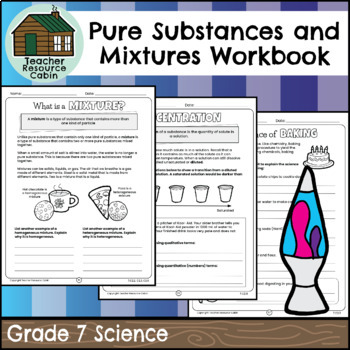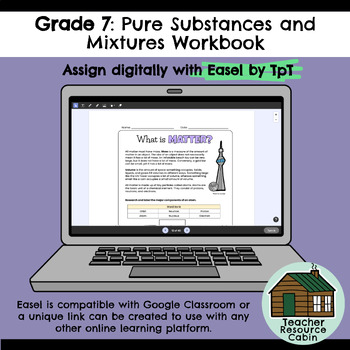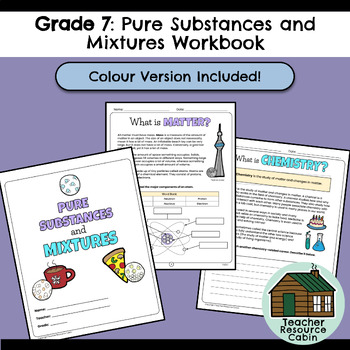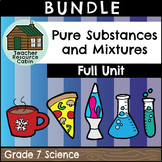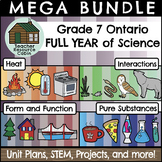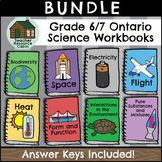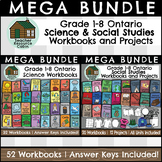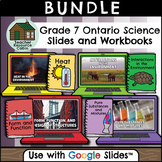Pure Substances and Mixtures Workbook (Grade 7 Ontario Science)
- Zip
- Easel Activity
What educators are saying
Also included in
- This full unit contains everything you need for teaching the Grade 7 Pure Substances and Mixtures unit in the NEW 2022 Ontario Science Curriculum! This unit includes a FULL unit plan (with suggestions for 21 daily lessons), a workbook, a slideshow, STEM experiments/investigations, a final project, aPrice $33.52Original Price $37.25Save $3.73
- This full unit MEGA BUNDLE contains everything you need to teach Grade 7 Science, aligned with the NEW 2022 Ontario Science Curriculum! All four Grade 7 Science units are included: Interactions in the Environment, Pure Substances and Mixtures, Form, Function, and Design of Structures, and Heat in thPrice $130.00Original Price $153.00Save $23.00
- This BUNDLE includes FOUR independent workbooks for Grade 7 students aligned with the NEW 2022 Ontario Science curriculum. Each workbook meets the Ontario Curriculum expectations for an ENTIRE Science unit.All four Grade 7 Science strands are included: Interactions in the Environment, Pure SubstancePrice $35.00Original Price $39.00Save $4.00
- This BUNDLE includes EIGHT independent workbooks for Grade 6 and Grade 7 students. Each workbook meets the Ontario Curriculum expectations for an ENTIRE Science unit.In total, the workbooks include 367 pages of student worksheets! Interactive, hands-on activities are explained, with follow-up workshPrice $69.25Original Price $78.25Save $9.00
- This BUNDLE includes EIGHT independent workbooks for Grade 7 and Grade 8 students. Each workbook meets the Ontario Curriculum expectations for an ENTIRE Science unit.In total, the workbooks include 369 pages of student worksheets! Interactive, hands-on activities are explained, with follow-up workshPrice $69.00Original Price $78.00Save $9.00
- This MEGA BUNDLE contains workbooks for ALL Grade 1 - 8 Ontario Science Units. Each workbook meets the NEW 2022 Ontario Science Curriculum expectations for an ENTIRE Science unit. This product is PERFECT for a prep coverage teacher that teaches science to multiple grade levels. All workbooks are no-Price $292.00Original Price $313.25Save $21.25
- This MEGA BUNDLE contains workbooks for ALL Grade 1-8 Ontario Science and Social Studies Units. Each workbook meets the Ontario Curriculum expectations for an ENTIRE Science or Social Studies unit.This product is PERFECT for a prep coverage teacher that teaches science and social studies to multiplePrice $464.40Original Price $580.50Save $116.10
- This MEGA BUNDLE contains workbooks for ALL Grade 1-8 Ontario Science, Social Studies, and Health Units. Each workbook meets the Ontario Curriculum expectations for an ENTIRE Science, Social Studies, and Health unit.This product is PERFECT for a prep coverage teacher who teaches Science, Social StudPrice $688.80Original Price $861.00Save $172.20
- This BUNDLE includes complete student workbooks and slide decks for Grade 7 students, aligned with the new 2022 Grade 7 Ontario Science curriculum. Each workbook meets the Ontario Curriculum expectations for an ENTIRE Science unit. Slide decks are accessed using Google Slides™. All four Grade 7 SciPrice $72.50Original Price $81.50Save $9.00
Description
This workbook covers the Grade 7 Pure Substances and Mixtures unit in the NEW 2022 Ontario Science curriculum (Matter and Energy).
Students will demonstrate an understanding of the nature of matter, including the properties of pure substances and mixtures, and describe these properties using particle theory. Topics covered include matter, particle theory, pure substances, mixtures, homogeneous/heterogeneous mixtures, separating mixtures, environmental impacts and more!
Interactive, hands-on activities are explained, with follow-up worksheets included. There is a variety of readings, long and short answer questions, creative writing activities, and drawing prompts included to create a varied workbook suitable for many learning styles.
To support assessment practices, Ontario curriculum expectations (Strand A and C) are clearly identified on each page. A quiz is included at the end of the workbook.
Available in French: Les substances pures et les mélanges cahier (Grade 7 FRENCH Ontario Science)
⭐ Looking for slides to accompany these workbooks? Pure Substances and Mixtures for Google Slides™
This resource includes:
- 45-page Pure Substances and Mixtures Workbook (B&W and Colour)
- 45-page Pure Substances and Mixtures ANSWER KEY
- TpT Easel Activity - This tool allows students to complete workbook pages digitally, with no printing necessary. New to using Easel by TpT? Check out this guide.
Table of Contents
- Title Page
- Table of Contents
- K-W-L Chart
- What is Chemistry?
- What is Matter?
- What is Matter?
- States of Matter
- Changing States
- Changing States
- Particle Theory
- Particle Theory Questions
- Pure Substances and Mixtures
- What is a Pure Substance?
- What is a Mixture?
- Heterogeneous Mixtures
- Homogenous Mixtures
- Pure Substances and Mixtures
- Solutes and Solvents
- Solutes and Solvents
- Solutes and Solvents
- Saturation
- Concentration
- The Universal Solvent
- Comparing Mixtures
- Separating Mixtures
- Separating Mixtures
- Industry Methods
- Industry Methods
- Industry Methods Questions
- Industry Methods Questions
- Industry Methods Questions
- Environmental Impacts
- Environmental Impacts
- Environmental Impacts
- Environmental Impacts Research
- Disposal of Technological Devices
- The Science of Baking
- Lava Lamp Experiment
- Lava Lamp Experiment
- Vocabulary
- Vocabulary
- Vocabulary
- Pure Substances and Mixtures Quiz
- Pure Substances and Mixtures Quiz
- Pure Substances and Mixtures Quiz
Grade 7 Ontario Science Curriculum Expectations (2022)
C. Matter and Energy - Pure Substances and Mixtures
C1. evaluate the environmental and social impacts of the use and disposal of various pure substances and mixtures
C2. demonstrate an understanding of the nature of matter, including the properties of pure substances and mixtures, and describe these properties using particle theory
Please read our Terms of Use prior to using this resource.
©Copyright Teacher Resource Cabin
Buyer Tip:
If you have purchased this product, please leave feedback! We are always looking for ways to improve our store and your input is important. You will earn TpT Credits by leaving ratings and reviews on your purchases. For every $1 you spend on TpT, you can earn 1 credit. Every 20 credits earned equals $1 you can apply to future TpT purchases.

